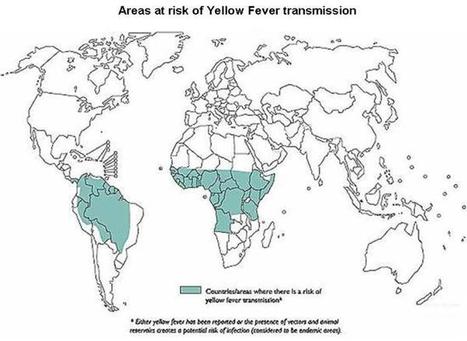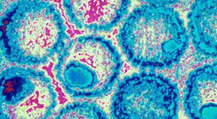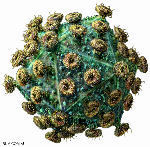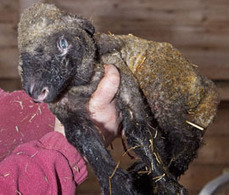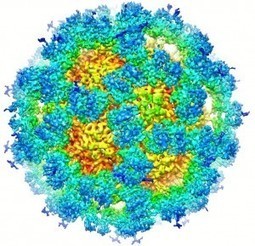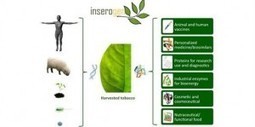 Your new post is loading...
 Your new post is loading...

|
Scooped by
Ed Rybicki
March 24, 2012 10:28 AM
|
A healthcare worker in North Wales is among a further six people clinically diagnosed with measles following a recent outbreak, taking the total tally of cases to 42. And this is a COMPLETELY VACCINE-PREVENTABLE DISEASE. Stupidity really is contagious.

|
Scooped by
Ed Rybicki
March 24, 2012 9:21 AM
|
THERE. IS. NO. YELLOW. FEVER. IN. SOUTH. AFRICA. WHO does NOT think so - and there is a map to prove it.

|
Scooped by
Ed Rybicki
March 24, 2012 9:06 AM
|
Transitions between saline and fresh waters have been shown to be infrequent for microorganisms. Based on host-specific interactions, the presence of specific clades among hosts suggests the existence of freshwater-specific viral clades.

|
Scooped by
Ed Rybicki
March 23, 2012 6:19 AM
|
“HIV” remains one of the most feared words around the world. Despite efforts of the government and voluntary organizations to spread awareness about HIV Infection & Prevention, some myths continue to exist. Nice infographics: print and share; there are still lunatics out there who deny the existence of HIV and AIDS - and woefully ignorant people.

|
Scooped by
Ed Rybicki
March 23, 2012 6:08 AM
|
Marijuana-like chemicals can directly inhibit a type of human immunodeficiency virus (HIV) found in late-stage AIDS, reveals study. Hey, man - this weed is like, chemotherapeutic, man!

|
Scooped by
Ed Rybicki
March 23, 2012 6:06 AM
|
Polio cases in Africa were almost halved in 2011, but the disease shows worrisome trends in some countries, health officials reported today as the continent geared up to vaccinate 111 million children against the disease. Although polio cases tripled in Nigeria, Africa's only polio-endemic country, from 21 in 2010 to 62 in 2011, the continent's overall count dropped from 657 in 2010 to 350 in 2011, according to an update in Morbidity and Mortality Weekly Report (MMWR) from the World Health Organization (WHO) and the US Centers for Disease Control and Prevention (CDC). The 1-year drop, however, was entirely attributed to a decline in cases reported from periodic outbreaks in one country, the Republic of Congo. Eight African countries experienced intermittent polio outbreaks in 2011, with transmission interrupted in six of them, according to the report. However, such outbreaks accounted for just 58 cases in 2011, compared with 477 in 2010. The lion's share of this drop resulted from the situation in the Republic of Congo, which reported 441 polio cases in 2010 but only 1 in 2011. Cote d'Ivoire had the most outbreak-related cases in 2011, with 36, after recording none in 2010. Last year's trends were mixed in the three African nations where polio transmission has become reestablished. Cases dropped from 33 in 2010 to 5 in Angola and from 100 to 93 in the Democratic Republic of the Congo (DRC) but increased from 26 to 132 in Chad. A welcome development - maybe polio will be the third virus to be eradicated?? Image courtesy of Russell Kightley Media

|
Scooped by
Ed Rybicki
March 23, 2012 3:21 AM
|
What can I say: slow day.

|
Scooped by
Ed Rybicki
March 23, 2012 3:13 AM
|
Here we devised a chemoenzymatic labeling strategy to site-specifically append probes to the influenza hemagglutinin (HA) and neuraminidase (NA) proteins using the bacterial sortase A enzyme. Because labeling is confined to surface exposed HA and NA in the context of live, infected cells, it is possible to study budding biochemically and microscopically in real-time. Using this system, we can observe budding of flu virions from discrete sites at the cell surface. Our work will enable detailed investigation into the birth of viruses from infected host cells and can likely be applied to viruses other than influenza that have been similarly resistant to real-time microscopic observation during budding. Virology tools just get better and better.

|
Scooped by
Ed Rybicki
March 22, 2012 11:30 AM
|
'More Doctors 'Fire' Vaccine Refusers,' according to a recent headline in the Wall Street Journal. Some physicians have had enough of parents with unfounded medical concerns who won't vaccinate their children. First Rule of the Herd: shun freeloaders.

|
Scooped by
Ed Rybicki
March 22, 2012 11:24 AM
|
London: Viruses which often cause dangerous infections could soon be the latest weapon in the war against cancer, scientists have claimed. A team of researchers in the US have claimed that they are creating viruses that would be weak to damage healthy cells but strong enough to destroy cancer cells. Scientists have already known that viruses can weaken cancer since the turn of the century. However, early efforts to use this knowledge to cure patients largely failed as recovery was only temporary and sometimes sufferers died of the infection. Research into cures
then shifted to other treatments. But, now following new understanding about genetics and how viruses and cancers work together, doctors have realised that specially tailored viruses might be the answer. Viva! Viruses, viva!

|
Scooped by
Ed Rybicki
March 22, 2012 11:16 AM
|
"We want people to have informed choice when it comes to vaccines." These words, or at least something along these lines, are uttered by many anti-vaccine activists, like Barbara Loe Arthur (aka Barbara Loe Fisher) of the misnamed National Vaccine Information Center or the authors at Age of Autism. To hear them speak, you would imagine that they would be completely in favor of any efforts which strive to provide accurate, complete information to parents who are deciding whether or not to have their children vaccinated. Such efforts should be whole-heartedly embraced by these "pro-informed consent" warriors. There are something like THREE HUNDRED THOUSAND anti-vaccination web sites right now. Boycott one today!

|
Scooped by
Ed Rybicki
March 22, 2012 11:09 AM
|
A genetic marker that may protect some people against HIV infection has been found, a new study from researchers in France suggests. This genetic marker occurs less frequently in people infected with HIV than in people who do not have the virus, the study showed. If confirmed, it would be the second genetic marker ever found to give people some resistance to the infection that causes AIDS. The only such marker known to date is a particular mutation in a gene called CCR5. This gene, which is found in about 1 percent to 2 percent of people of European decent, provides near-complete protection against HIV infection, the researchers say. Read more: http://www.foxnews.com/health/2012/03/22/new-genetic-marker-may-protect-some-people-against-hiv/#ixzz1prILSOxR Image courtesy Russell Kightley Media

|
Scooped by
Ed Rybicki
March 20, 2012 7:38 AM
|
The enduring quest for a coffee bean without the buzz. Coffee contains some 2,000 chemical compounds that give the drink its enticing aroma and flavour, including caffeine, a stimulant and natural pesticide. Removing the caffeine while leaving all the others intact poses a significant challenge. But I LIKE the buzz.
|

|
Scooped by
Ed Rybicki
March 24, 2012 10:26 AM
|
The back story of the new cervical-cancer vaccine includes, among its many twists: Warts, Italian nuns, a virus old as humanity, a German scientist... Quite a nice historical account of how HPV vaccines - or one of them, anyway - came to be. Of course, HPVs almost certainly evolved a lot longer than a million years ago, but that's by the bye.

|
Scooped by
Ed Rybicki
March 24, 2012 9:19 AM
|
Yellow fever is endemic not only in South Africa, but also in 33 other countries of the continent with a combined population of 508 million. ..., Srikanth Radhakrishna... THERE. IS. NO. YELLOW. FEVER. IN. SOUTH. AFRICA. Are we clear on this? Unless it is imported from another country - because it is assuredly NOT endemic!! And irresponsible statements like this do not help anyone - except certain vaccine clinics.

|
Scooped by
Ed Rybicki
March 23, 2012 6:21 AM
|
This lesson, using the 1918 influenza epidemic as a starting point from which to understand dimensions of the 1920s, was taught to two US History classes in demonstration lessons at Columbia River High School on February 10, 2012. Students gathered in the school computer lab to explore the document set, organized into a Prezi. Based on observations of the first class, the group revised the question tool for the second class. The format, inquiry model, and reflection tool seemed to serve the students well. An interesting account for us (sometime) teachers: sometimes it's useful to use contemporary info.

|
Scooped by
Ed Rybicki
March 23, 2012 6:14 AM
|
Australia was the first country to introduce a free HPV vaccination program for girls but the US and Canada have moved first to routinely vaccinate boys. Australia must act quickly to vaccinate schoolboys against human papillomavirus (HPV) or risk lagging behind other developed countries, health experts say. Makes sense: affects mainly women, but spread by both sexes. Pity it COSTS so much. Image courtesy Russell Kightley Media

|
Scooped by
Ed Rybicki
March 23, 2012 6:07 AM
|
Scientists have developed a test that could be used to detect the Schmallenberg virus in the blood of animals in the field, it has emerged. First step to dealing with it - now for the vaccine!!

|
Scooped by
Ed Rybicki
March 23, 2012 3:24 AM
|
While researchers say that vaccines for intestinal infections are among the most difficult to develop, a recent discovery may provide the critical information needed for success. “Sometimes atomic structure gives us clues on how viruses work and how to make better vaccines,” said Dr. Thomas Smith, principal investigator, at The Donald Danforth Plant Science Center whose recent article, Structural Basis for Broad Detection of Genogroup II Noroviruses by a Monoclonal Antibody That Binds to a Site Occluded in the Viral Particle, in the Journal of Virology was selected by the editors as an, “Article of Significant Interest, sighting the extreme norovirus flexibility suggested by these results may allow for broad antibody recognition, a finding of potential vaccine significance.”

|
Scooped by
Ed Rybicki
March 23, 2012 3:18 AM
|
According to analysts of the World Bank, the immediate impact due to such flu pandemics would not be the loss of lives but it is the shock cause to the economy, which could provide a thumping blow. When the world became technologically advanced and scientifically competent, the loss of life associated with flu pandemics decreased phenomenally and it is evident when thinking of the enormous loss of life due to the flu pandemic in 1919s, which was estimated to be about 50 million deaths, with the confirmed loss of 1500 – 2000 lives due to H1N1 pandemic. All the more reason to vaccinate, then! Image courtesy of Russell Kightley Media

|
Scooped by
Ed Rybicki
March 22, 2012 11:34 AM
|
Tobacco use is responsible for almost half a million deaths in the U.S. each year, but the tobacco plant could find redemption as a savior for public health.That’s because a U.S. biotechnology startup has transformed tobacco plants into living factories for making new vaccines and medical treatments. The “SwiftVax” tobacco plants are designed to act as quick, cheap biological factories for churning out bioengineered proteins needed for human or animal vaccines. Faster vaccine manufacturing could allow the world to respond rapidly to future outbreaks of infectious diseases — a problem it faced while racing to stockpile vaccine during the H1N1 swine flu pandemic. You'd think they invented it - but it's a nice little puff piece for plant-made pharmaceuticals.

|
Scooped by
Ed Rybicki
March 22, 2012 11:27 AM
|
Cures for AIDS may have failed because we don't fully understand how HIV evolves, a researcher says. University of Adelaide researcher Jack da Silva has used computer simulations to discover that even in early infection when the virus population is low, HIV rapidly evolves to evade immune defences and treatments. His findings, published in GENETICS journal, challenge the belief that evolution of the virus under these circumstances is very slow.

|
Scooped by
Ed Rybicki
March 22, 2012 11:17 AM
|
Laboratory studies have long established that a class of HIV antiretrovirals known as protease inhibitors can cripple the malaria parasitePlasmodium, and researchers from Uganda and the United States wanted to better ... SOMETHING good out of the HIV pandemic!!

|
Scooped by
Ed Rybicki
March 22, 2012 11:12 AM
|
iBio's ($IBIO) shares have jumped 21% with the announcement that it has completed the first Phase I clinical trial of its plant-based vaccine for H1N1 influenza, HAC1. The study of the vaccine, produced by iBio's partner the Fraunhofer USA Center for Molecular Biotechnology, aimed to assess the vaccine's safety, as well as looking for early clues to its ability to trigger an immune response against the flu virus. The study showed that the vaccine was safe and well-tolerated at low and high doses, regardless of whether an adjuvant was used. The vaccine also triggered immune responses, with the best immune response seen in the people who received the highest dose of the vaccine without an adjuvant. This was a similar response to a marketed flu shot. Read more: iBio shares jump with flu shot clinical trial - FierceVaccines http://www.fiercevaccines.com/story/ibio-shares-jump-flu-shot-clinical-trial/2012-03-22#ixzz1prIpScl0 Going green: the right thing to do. Image courtesy Russell Kightley Media

|
Scooped by
Ed Rybicki
March 22, 2012 11:07 AM
|
Here we report the detection of serological responses against EBV capsid antigens in healthy dogs and dogs with spontaneous lymphoma and that dogs with the highest antibody titers have B cell lymphoma. Moreover, we demonstrate the presence of EBV-like viral DNA and RNA sequences and Latent Membrane Protein-1 in malignant lymph nodes of dogs with lymphoma. Finally, electron microscopy of canine malignant B cells revealed the presence of classic herpesvirus particles. These findings suggest that dogs can be naturally infected with an EBV-like gammaherpesvirus that may contribute to lymphomagenesis and that dogs might represent a spontaneous model to investigate environmental and genetic factors that influence gammaherpesvirus-associated lymphomagenesis in humans. VERY interesting...a most unexpected place to find a useful human model for herpesvirus disease!
|



 Your new post is loading...
Your new post is loading...


